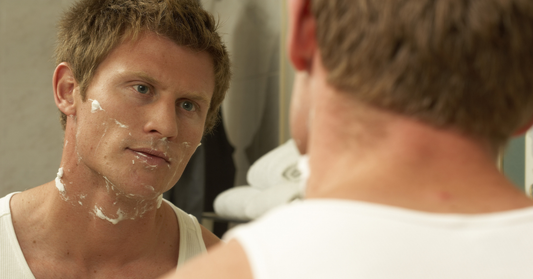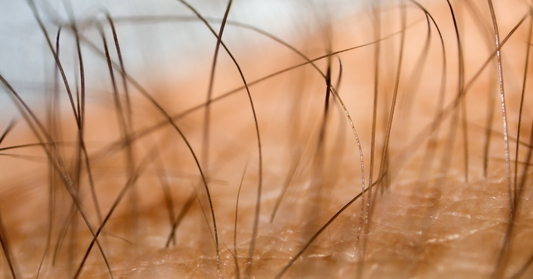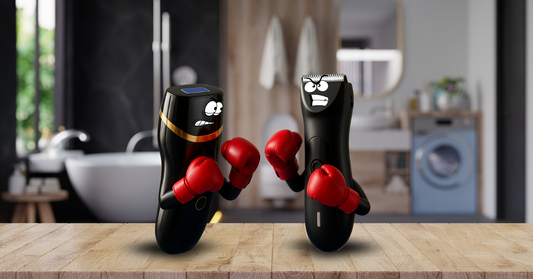
Not All Hair Is Equal: The Secret Cartography of the Male Body
Think a mate would love this? Share it.
OPINION
How testosterone shapes our hair landscape—and what to do when each region demands its own grooming strategy.
🖊️ Written by The Nutsmate Team | ⏱️ 8 min read
When a bloke looks in the mirror at seventeen, he sees one landscape; by thirty, that same reflection shows another; and after forty, the geography shifts again. Every blink of our life is echoed by a keratin thread that appears, thickens, or migrates to places as unexpected as they are fascinating. Powering that transformation is a biochemical engine: testosterone—and its turbo-charged cousin, dihydrotestosterone (DHT). These hormones tell each follicle when to wake, how much to grow, and, when the time comes, where to retreat.
From the First Whisker to the Hormone Revolution
During puberty, testosterone surges as if someone opened a floodgate. Overnight, hair sprouts in the groin and armpits; a faint shadow creeps across the upper lip; the chest hosts its first pioneers. Skin is still thick, hair is fine—almost cotton-like. By twenty, androgens peak: the beard bulks up, the torso takes on character, and the legs sport the thermal blanket that will stay with us for life.

But testosterone never sits still. Around thirty it begins a slow decline—so gradual we barely notice—while DHT clings to select follicles. The visible consequences? A subtle retreat of the hairline, the hint of a bald spot, and, above all, the quirky “invasion” of nose and ear hair. Those strands serve a defensive mission (filtering dust and regulating humidity), yet their post-forty enthusiasm demands diplomatic precision.
A Stroll from Crown to Ankles
The torso and abdomen are perhaps the most visible emblems of masculine hairiness. Men who inherit plenty of DHT receptors sport a comic-book “rug”; those who don’t enjoy an almost child-smooth plain. Both scenarios are perfectly normal—the difference lies in management. A body trimmer with ceramic blades and adjustable guards keeps things tidy without sacrificing skin health.
Further south, the intimate zone blends coarse, curly hair with sweat glands on overdrive. Hygiene rules here. Trim it and you’ll have less moisture and friction. Swap the blade regularly to avoid tugging: the skin is thin, follicles dense, and precision is everything.
Spin around and you reach the back, as invisible to its owner as it is obvious to everyone else. Genetics decides whether the hair there is a scattering or a proper carpet. Age wakes follicles irregularly, forging “islands” some find bothersome. Long-reach handles—or a helpful partner—are priceless on this battlefield.
On the legs, hair acts like plumage: cushioning friction and regulating heat. Many runners trim for comfort; others leave it because it’s part of their natural thermostat. The trick is to clip, not shave; that prevents the next-day “cactus” feel.

Now to the true stars of maturity: nose and ears. Their late-blooming growth is simple to explain: these zones keep DHT receptors that, after losing ground on the scalp, claim their hormonal share. Result: longer, darker, tougher strands sprouting steadily after forty. Scissors won’t cut it—nasal mucosa is delicate and ear anatomy tricky. A rotary trimmer like the Nutsmate Nose & Ear Groomer shears with millimetric safety, no irritation, no sharp edges.
Finally, the eyebrows. For decades they remain discreet, silent sweat guards. Past the fourth decade, the anagen (growth) phase lengthens: hairs get thick, stubborn, often lighter. Leave them unchecked and they colonise the forehead; shave them and density is lost. The sensible fix is brushing upwards, snipping the strays, and, when needed, shaping the outline with a two-millimetre guard. Keeping them in line isn’t vanity; it lets more light into the eyes and stops rogue filaments poking the cornea.

The Right Blade at the Right Time
Each life stage calls for a different tool. A twenty-year-old needs only a long guard to learn technique; the thirty-something chases sharp outlines; the forty-something welcomes a specialised kit with precision heads for nose and ears; and the sixty-something opts for a quiet motor, fresh blades, minimal skin contact. Switching trimmers isn’t surrender—it’s smart adaptation to biology’s playbook. If testosterone moves the pieces, we still choose the board.
Closing Ranks, Lifting the Gaze
Hair may never appear where we want and always pop up where we don’t, yet that’s its charm: it’s the diary of our evolution. Learning to read it—and, when needed, trim it—is an act of respect for the body. A sculpted beard, an airy chest, or ears free of “antennae” don’t rob masculinity; they amplify it, speaking of attention, self-care, and awareness. Science has gifted us high-torque motors, ceramic blades, IPX7 seals—taking advantage is as natural as the hair itself.
Final thought
The years will keep writing chapters on your skin; some follicles will fall silent, others will raise their voice. Keep the tool that speaks best to each one within reach. Mastering your hair cartography isn’t a battle against nature but a pact of elegance with it.
🎯 Ready to Own Your Style?
Discover the Nutsmate Groin & Body Hair Trimmer — engineered for power, comfort, and total control. Whether it’s chest, back or beyond, it’s your body. Groom it your way.




